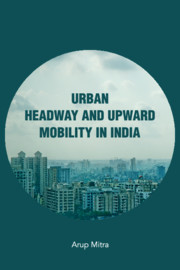Book contents
- Frontmatter
- Contents
- List of Tables
- Acknowledgements
- 1 Analytical Frame
- 2 Assessing the Quality of Cities and Towns
- 3 New Patterns and New Strategies in Indian Urbanization
- 4 Growth, Informal Sector Employment and Poverty
- 5 Upward Mobility of the Disadvantaged Sections
- 6 Erosion of the Caste Factor?
- 7 Changes in a Cultural Variable
- Bibliography
- Index
7 - Changes in a Cultural Variable
Published online by Cambridge University Press: 30 April 2020
- Frontmatter
- Contents
- List of Tables
- Acknowledgements
- 1 Analytical Frame
- 2 Assessing the Quality of Cities and Towns
- 3 New Patterns and New Strategies in Indian Urbanization
- 4 Growth, Informal Sector Employment and Poverty
- 5 Upward Mobility of the Disadvantaged Sections
- 6 Erosion of the Caste Factor?
- 7 Changes in a Cultural Variable
- Bibliography
- Index
Summary
Perspective
Urbanization envisaged as a process of transformation of ideas and ideologies is expected to counter social backwardness. Poor cultural practices and strong gender biases are expected to get eroded with modernization following as a concomitant of urbanization. This chapter proposes to focus on how the women workforce participation rate (WFPR), which is considered to be a variable influenced more by cultural factors than economic changes, responds to the shifts in the levels of urbanization. Further, Odisha being one of the backward states in India is expected to be within the realms of gendered division of labour, and hence, as a matter of illustration, this state is considered for an in-depth analysis though the district-level data across India are also included. In this context whether urbanization is able to mitigate the influence of social backwardness is a critical question. Which types of rural transformations are in progress and whether they allow women to participate in the labour market more explicitly is a pertinent question. Similarly, in the urban context, whether economic growth is ushering in opportunities for women to participate in remunerative activities is a key issue. Overall, the chapter looks at urbanization, economic growth, and poverty on the one hand and the changing role of women in this dynamic context on the other.
Among various supply and demand side factors, which impinge on women WFPR, economic growth and urbanization are said to be strong determinants (see Mathur, 1994; Agarwal, 1985; Durand, 1975; Sinha, 1965). Initially, growth is found to have a negative impact on WFPR but at higher levels of growth WFPR tends to increase, thus giving rise to a U-shaped relationship. Cagatay and Ozler (1995) also suggest the possibility of a U-shaped relationship between the long-term development and women's share in the labour force. Even the historical records of developed countries indicate such a relationship between economic development and women's labour force participation rate (LFPR) (Goldin, 1994).
With urbanization and industrialization, female-dominated home-based production is expected to decline as it would be largely replaced by male-dominated factory production (Boserup, 1970). This falling part of the U-shape curve corroborates Boserup's analysis of women's contribution to home-based production.
- Type
- Chapter
- Information
- Urban Headway and Upward Mobility in India , pp. 141 - 165Publisher: Cambridge University PressPrint publication year: 2020



